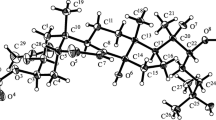Abstract
Molecular associations of beta-cyclodextrin (beta-CyD) with four steroids (cortisone, hydrocortisone, progesterone, and testosterone) have been studied using phase-solubility and spectroscopic techniques. Phase solubility diagrams could be categorized as B type. The complexes are formed at the stoichiometric ratios of 1:2 (drug:beta-CyD). A mathematical model has been proposed to calculate the apparent stability constants. The results suggest that the inclusion of a steroid molecule into the first beta-CyD cavity is thermodynamically more favorable over the association of 1:1 complex with the second beta-CyD molecule except for cortisone, which exhibits anomalous behavior. A mechanism of complexation has been proposed based on the apparent stability constants and chemical structures of the steroids and beta-CyD. It suggests that complexation is first brought about by inclusion of the five-member cyclopentane ring of the steroid molecule into the first beta-CyD cavity. The 1:1 complex subsequently binds with the second beta-CyD to form the 1:2 complex. The association constants of steroid/beta-CyD complexes are of the following order: progesterone > cortisone > testosterone > hydrocortisone. The order of aqueous solubilities of the complexes is hydrocortisone > cortisone > testosterone > progesterone.
Similar content being viewed by others
REFERENCES
J. Pitha, S. M. Harman, and M. E. Michel. J. Pharm. Sci. 75:165–167 (1986).
K. Uekama, K. Arimori, A. Sakai, K. Masaki, T. Irie, and M. Otagiri. Chem. Pharm. Bull. 35:2910–2913 (1987).
J. L. Lach and W. A. Pauli. J. Pharm Sci. 33:32–38 (1966).
K. Uekama, T. Fu**aga, F. Hirayama, M. Otagiri, and M. Yamasaki. Int. J. Pharm 10:1–15 (1982).
K. Koizumi, Y. Okada, Y. Kubota, and T. Utamura. Chem. Pharm. Bull. 35:3413–3418 (1987).
S. Y. Lin, Y. H. Kao, and J. C. Yang. Drug Dev. Ind. Pharm. 14:99–118 (1988).
T. Higuchi and K. Connors. Adv. Anal. Chem. Instr. 4:117–212 (1965).
K. M. Boje, M. Sak, and H. L. Fung. Pharm. Res. 5:655–659 (1988).
R. B. Gandhi and A. H. Karara. Drug Dev. Ind. Pharm. 14:657–682 (1988).
M. Miyahara and T. Takahashi. Chem. Pharm. Bull. 30:288–295 (1982).
K. Kakemi, H. Sezaki, T. Mitsunaga, and M. Nakano. J. Pharm. Sci. 59:1597–1600 (1970).
Author information
Authors and Affiliations
Rights and permissions
About this article
Cite this article
Liu, Fy., Kildsig, D.O. & Mitra, A.K. Beta-Cyclodextrin/Steroid Complexation: Effect of Steroid Structure on Association Equilibria. Pharm Res 7, 869–873 (1990). https://doi.org/10.1023/A:1015973218303
Issue Date:
DOI: https://doi.org/10.1023/A:1015973218303




